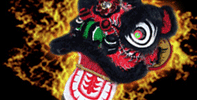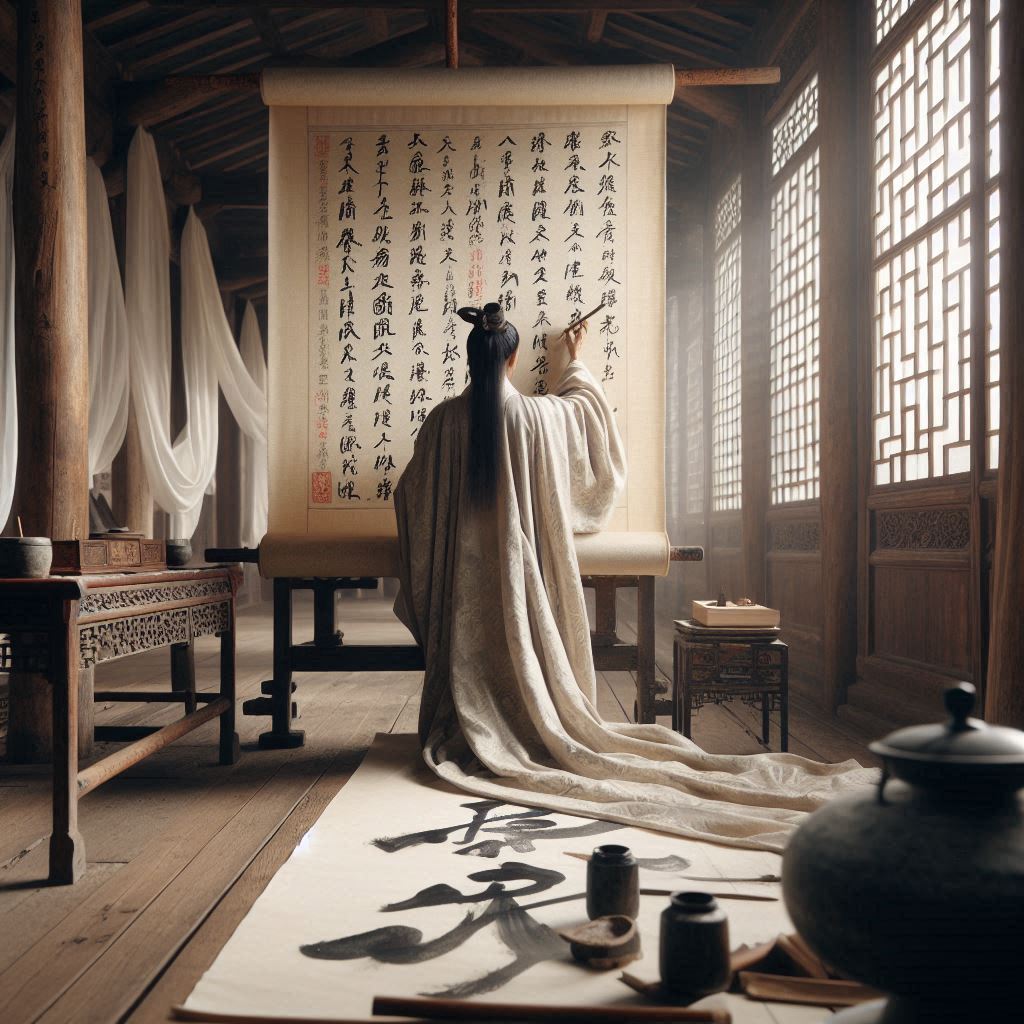The northern Chinese language is Mandarin.
The characters are Chinese Simplified.
The official romanization (Latin spelling) is pinyin.
The old romanization is Wade-Giles,
which uses apostrophes and superscript numbers.
Informal Wade-Giles often removes the apostrophes and numbers.
The southern Chinese language is Cantonese.
The characters are Chinese Traditional.
The newest romanization (Latin spelling) is Jyutping from the 1990s,
which uses numbers after syllables for tones.
A common older romanization is Yale, which uses accents and apostrophes.
There are other older ones, like Cantonese pinyin from the 1950s, Sidney Lau, and Meyer-Wempe.
There are also informal romanizations using the pronunciations.
There are also other dialects with their own romanization,
such as Hokkien, Teochew, and Shanghainese.
Man Sau
问手
|
Inquisitive Or Seeking Hand
This technique is introduced in the Sil Lim Tao form and, combined with Wu Sau forms the basic structure of the Yee Gee Kim Yeung Ma "Ready" state. It is used to gain contact with the opponent, but it can also be used to block and deflect incoming attacks. It can mean to Bridge on guard or ask the way.
|
Man Geng Sau
问勁手
|
Neck Pulling Hand
|
Kau Sau
扣手
|
Scooping Or Detaining Hand
Across Bong Sao
|
Kwan Sau
綑手
|
Rotating Arms Or Double Wiper Hands
Tan and Gaun Deflection
|
Lap Sau
拉手
|
Deflective Hand Or Pulling Arm
This technique is introduced in the Sil Lim Tao form but is also in the Muk Yang Jong (Wooden Dummy) form. It is used to destroy the balance and structure of an opponent through the application of a short sharp pull. It has many uses most of which will are accompanied by a simultaneous strike to deliver devastating force.
|
Lan Sau
拦手
|
Bar Or Bannister Arm
This is a lifting block or bridging technique, which is introduced in the Sil Tim Tao form. The forearm is level with the shoulders and more or less parallel to the body.
|
Huen Sau
圈手
|
Circling Or Rotating Hand Or Small Circle Block
This technique is introduced in the Sil Lim Tao form but is also used in Chum Kiu , Biu Gee , and the Muk Yang Jong (Wooden Dummy) forms. It is used to change position whilst still controlling your attacker's arm. It is also used to remove an obstacle that is stopping you from striking your target.
|
Jeung Sau
掌手
|
Changing Arms
|
Dai Bong Sau
低膀手
|
Low Wing Arm Or Sinking Bridge
This technique is the application of the Bong Sau , introduced in the Sil Lim Tao form to cover the high-gate, used lower to cover the mid/low-gate.
|
Fak Sau
拂手
|
Whisking Arm
This is a chop technique introduced in the Sil Lim Tao form. It can be used as a block or a strike and is useful for defending and attacking opponents who are to the side, not in front of the practitioner.
|
Fook Sau
伏手
|
Controlling Or Bridge Hand
This technique is used to bridge on an opponent's arm. It is relatively simple but effective movement that is first introduced in the Sil Lim Tao form. It is used in extensively in Chi Sau but can be applied as a deflection or block, or to control an opponent's limb after the execution of a striking technique.
|
Gaan Sau
耕手
|
Low Block Or Splitting Arm Or Plowing Hand Or Downward Block
This is used to block attacks to the mid section.
|
Gum Sau
撳手
|
Pinning Hand
This technique is introduced in the Sil Lim Tao form and is used as a block or to pin an opponent's arm. It is often used in Chi Sao .
|
Biu Sau
镖手
|
Thrusting Hand
This is one of the many Wing Chun moves which can be use as a block and a strike. It is used to deflect any attack around the shoulder height or above. It can be used to strike an opponent's eyes and throat.
|
Bong Sau
膀手
|
Crane Wing Deflection
This is a complex movement that is introduced in the Sil Lim Tao form. It is a deflective technique formed when another technique's structure, such as Taan Sau , is compromised by a punch crossing the centerline or when the wrists are being controlled.
|
Wu Sau
|
Protective Hand
|
Kuen Sau
|
Fist Or Punch
|
Jip Sau
|
Folding Hand
|
Tai Sau
|
Rising Hands
|
Tan Sau
|
Spread Hand
|
Lop Sau
|
Grab
|
Jung Sau
|
Downward Chop
|
Jut Sau
|
Jerking Hand
|
Fox Sau
|
Knife Palm
|
Sut Sau
|
Knife Palm
|
Kwok Sau
|
Snapping Wrist To A Fist
|
Pak Sau
|
Slapping Palm
|
Sub Ji Sau
|
Double Cross Low Hands
|
Fuk Sau
|
Hooking Hand
|
Bil Jee Sau
|
Thrusting Fingers
|
Tok Sau
|
Pulling Hands
|
Lau Sau
|
Large Circle Hand
|
Faat Sau
|
Swinging Arm
|
Moy Jut Sau
|
Wiping Hand With Reverse Chopping Fox Hand
|
Noi Kwan Sau
|
Inside Out Or Rolling Hands Outward
|
Dai Chang Sau
|
Fingers Facing Down Palm
|
Sup Gee Sau
|
|
Jing Jeung
正掌
|
Vertical Palm Strike
|
Dai Jeung
底掌
|
Low Or Reverse Palm Strike
This technique is introduced in the Sil Lim Tao form. It is used in section 3 of the form, following the Taan Sau , Huen Sau , and retraction of the arm. The Dai Jeung is a strike to the lower ribs.
|
Wan Jeung
|
Side Palm Strike
|
Gum Jeung
|
Pressing Elbow
|
Sau Jeung
|
Retracting Elbo Strike Back
|
Chow Jeung
|
Striking With Doward Palm, Elbow
|
Jak Jeung
|
Splitting Palm Strike
|
Po Pai Jeung
|
Double Or Opposite Palm Strike
|
Dai Kuen
底拳
|
Low Punch
This is used in the Third section of the Muk Yan Jong (Wooden Dummy) form. It is a straight punch to the main trunk of the dummy central between the two tops and single center arm.
|
Tai Kuen
|
Raising Punch
|
Lin Wan Kuen
|
Circle Punches
|
Sau Kuen
|
Retract Fist To Waist
|
Lan Da Chow Kuen
|
Grab With Striking Bottom Fist
|
Feng An Kuen
|
Phoenix Eye Fist
|
Jit Jung Choi
|
Three Straight Punches
|
Gup Choi
|
Upper Cut
|
Chung Choi
|
Vertical Fist
|
Ping Choi
|
Horizontal Fist
|
Jung Choi
|
Vertical Punch
|
Jut Da
|
Jerking Hand With Strike
|
Pak Da
|
Slapping Palm With Strike
|
Tan Da
|
Spreading Hand With Strike
|
Lau Gerk
|
Kick Defense
|
Yut Fook Yee
|
One Hand Trapping Two
|
Kuen Yao Sum Faat
|
Punching From Center Of Chest Or Heart
|
Saam Bai Tze
|
Triple Waving Snake Hands
|
Yau Pin Yap Sing
|
Moving From Side To Center
|
Hoy Sick Sequence With Sup Gee Sau
|
|
|
Charter Hand
Pointed Finger Bridge Hand
|



 Monday, November 17
Monday, November 17  Site Intro
Site Intro Guest Book
Guest Book Contact Us
Contact Us Mailing List
Mailing List Seminars
Seminars Products
Products School Location
School Location Testimonials
Testimonials Class Schedule
Class Schedule Coupons
Coupons Articles
Articles Forum
Forum Photo Gallery
Photo Gallery News
News Event Calendar
Event Calendar FAQ
FAQ


